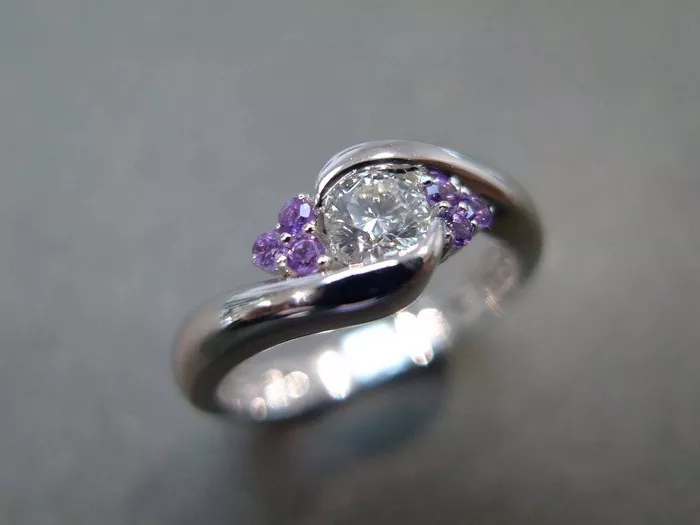Choosing an engagement ring is a significant decision, symbolizing love, commitment, and the promise of a future together. Traditionally, diamonds have been the gemstone of choice for engagement rings due to their durability and timeless beauty. However, as couples seek more unique and personalized options, other gemstones like amethyst are gaining popularity. But, is amethyst hard enough to withstand the daily wear and tear of an engagement ring? In this article, we’ll explore the characteristics of amethyst, its hardness compared to other gemstones, and considerations for using it in an engagement ring.
Understanding Amethyst
Amethyst is a variety of quartz, known for its stunning purple hues ranging from pale lilac to deep violet. It has been treasured for centuries for its beauty and spiritual significance. The color of amethyst is caused by irradiation and impurities of iron within the quartz crystal lattice. This gemstone is found in various locations worldwide, including Brazil, Uruguay, Russia, and Zambia.
Hardness Scale and Durability
The hardness of a gemstone refers to its resistance to scratching and abrasion. The Mohs scale of mineral hardness, developed by German mineralogist Friedrich Mohs in 1812, ranks minerals on a scale from 1 to 10, with 10 being the hardest (diamond) and 1 being the softest (talc). This scale is widely used in the gemstone industry to assess the durability of different stones.
Amethyst has a Mohs hardness of 7, which makes it relatively durable and suitable for everyday wear. However, it is important to note that while amethyst is not as hard as diamonds, rubies, or sapphires (which rank 9 on the Mohs scale), it is still harder than many other popular gemstones used in jewelry, such as opals and pearls.
Comparing Amethyst to Other Gemstones
To put amethyst’s hardness into perspective, let’s compare it to some other commonly used gemstones in engagement rings:
Diamond: As the hardest known natural material, diamond ranks 10 on the Mohs scale, making it extremely resistant to scratching and abrasion. This durability is why diamonds have long been favored for engagement rings.
Sapphire and Ruby: Both sapphires and rubies are varieties of the mineral corundum and rank 9 on the Mohs scale, just below diamond. They are highly durable and suitable for daily wear.
Emerald: Emeralds are a type of beryl and have a Mohs hardness of 7.5 to 8. While slightly harder than amethyst, they can still be prone to chipping and breaking if not handled with care.
Moissanite: Moissanite is a popular diamond alternative with a Mohs hardness of 9.25, making it even harder than sapphires and rubies. It is an excellent choice for those seeking a durable and affordable option for their engagement ring.
See Also: How Long Will an Amethyst Ring Last?
Factors to Consider
While amethyst’s hardness makes it suitable for everyday wear, there are some factors to consider before choosing it for an engagement ring:
Wear and Tear: While amethyst is relatively durable, it is not as resistant to scratches and chips as diamonds or sapphires. Therefore, it may require more frequent maintenance and care to preserve its beauty over time.
Setting Design: The design of the engagement ring setting can impact the durability of the gemstone. A protective setting, such as a bezel or halo setting, can help shield the amethyst from accidental damage.
Lifestyle: Consider your lifestyle and daily activities before selecting an amethyst engagement ring. If you lead an active lifestyle or work with your hands frequently, you may want to choose a harder gemstone to ensure the longevity of your ring.
Budget: Amethyst is typically more affordable than diamonds or other precious gemstones, making it an attractive option for budget-conscious couples. However, keep in mind that the cost of the ring is not the only consideration, and durability should also be taken into account.
Care and Maintenance
To keep your amethyst engagement ring looking its best, follow these care tips:
Regular Cleaning: Clean your amethyst ring regularly with mild soap and warm water to remove dirt and debris. Avoid using harsh chemicals or ultrasonic cleaners, as they can damage the stone.
Avoid Harsh Chemicals: Remove your ring before engaging in activities that may expose it to harsh chemicals, such as cleaning products or swimming pools.
Protective Storage: When not wearing your ring, store it in a soft cloth pouch or jewelry box to prevent scratches and damage.
Professional Inspection: Have your ring inspected by a professional jeweler periodically to check for loose stones or signs of wear.
Conclusion
In conclusion, while amethyst may not be as hard as diamonds or sapphires, it is still a durable and beautiful option for an engagement ring. Its Mohs hardness of 7 makes it suitable for everyday wear, but it may require more care and maintenance compared to harder gemstones. By considering factors such as setting design, lifestyle, and budget, couples can confidently choose an amethyst engagement ring that symbolizes their love and commitment for years to come.


